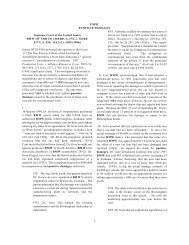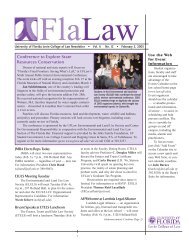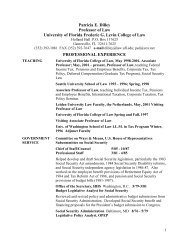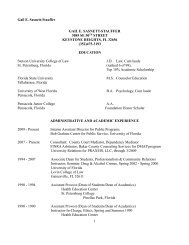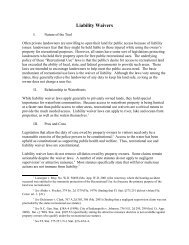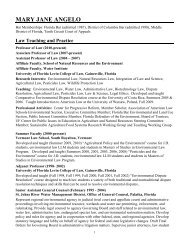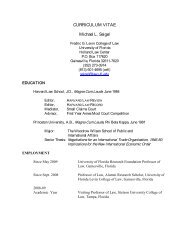Download Magazine - Levin College of Law - University of Florida
Download Magazine - Levin College of Law - University of Florida
Download Magazine - Levin College of Law - University of Florida
Create successful ePaper yourself
Turn your PDF publications into a flip-book with our unique Google optimized e-Paper software.
PART I:Making the case forelectronic practicemanagementBY ADRIANNA C. RODRIGUEZFor those attorneys whohave trouble programmingtheir VCRs — andyou know who you are— mastering technologyto install case and practicemanagement systems intheir law practices might seem like the impossibledream. The good news is that caseand practice management systems result inmore efficient use <strong>of</strong> attorney and staff timeand a boost in productivity, resulting in significantsavings to the firm that is a dreamcome true.The right case and practice managementsystems can help a firm’s attorneysand staff streamline both administrative, or“back <strong>of</strong>fice,” and pr<strong>of</strong>essional, or “front<strong>of</strong>fice” operations, such as case management,s<strong>of</strong>tware for substantive areas <strong>of</strong> law,docketing and calendaring, document assembly,litigation support and research.“With a case management system, thisis really putting technology in the hands <strong>of</strong>the lawyers,” said Andrew Z. Adkins III,director <strong>of</strong> the Legal Technology Institute.Adkins has been working with case andpractice management systems for morethan 20 years.Practice management combines casemanagement and other front <strong>of</strong>fice tasks,and back <strong>of</strong>fice tasks into one system.Firms conduct back <strong>of</strong>fice and front <strong>of</strong>ficetasks every day, but there is usually anoverlap in record keeping which results induplication <strong>of</strong> effort. Practice managementsystems allow for all those individual tasksto be stored in a central database, resultingin one-time data entry.Once data is entered, the central databaseallows for increased efficiency, productivityand effectiveness within a firm’sstaff and attorneys, in part because multipleusers can access the data simultaneouslyto quickly find information throughsearch functions.One <strong>of</strong> the challenges for firms establishingcase and practice management systemsis in identifying which <strong>of</strong> the multiplepractice management systems will work forthe entire firm and its individual attorneys.“The ways in which lawyers practicelaw are different. Even lawyers who practicethe same type <strong>of</strong> law, or lawyers in thesame firm, don’t do it the same way,” Adkinssaid. “Technology tends to standardizethe way we do things; for instance time andbilling is cut and dry, but you can’t reallystandardize the way that you practice lawand I think that’s one <strong>of</strong> the things holdingpeople back.”Through the Legal Technology Institute,Adkins travels to firms around the countryas a consultant. To date, the institute hasworked with more than 300 law firms, lawdepartments, courts and law schools.As a consultant, Adkins recommendsfirms implement case and practice managementsystems in three phases. First, theinterview phase where the firm’s needs areidentified and compiled into a report. Thisis followed by the implementation phasewhere the s<strong>of</strong>tware and hardware necessaryto establish the systems are put in place.Finally, the follow-up phase consisting <strong>of</strong>training and testing is completed.“Part <strong>of</strong> my job as a consultant is toeducate them as to what’s available,” Adkinssaid. “[The practice management systems]all basically do the same thing… .It’s the really nitpicky stuff that has to bediscussed.”While the set-up and implementationmight be time consuming, the benefits <strong>of</strong>installing a system that addresses the specificneeds <strong>of</strong> the firm, its attorneys andsupport staff pays <strong>of</strong>f in the form <strong>of</strong> “operatingefficiency,” increased efficiency andproductivity.In a presentation, “Turning CHAOSinto Cases,” Adkins estimated that implementingpractice management systemscould save each attorney in a firm 15 minutesper day. At $300 per hour, an additional15 minutes per day could translate into$375 per week, or $1,500 per month for atotal <strong>of</strong> $18,000 per year in increased billabletime.While case and practice managementsystems have come a long way, they stillhave a ways to go, according to Adkins.He estimates between 35 to 40 percent<strong>of</strong> law firms around the country use a caseor practice management system. He expectsadoption <strong>of</strong> case and practice managementsystems to peak at about 60 percent withinthe next five to seven years.Adkins has dubbed the latest in case andpractice management systems as the “fourthgeneration.” This newest technology has theadded capability <strong>of</strong> managing workflow bycreating a sort <strong>of</strong> checklist that automaticallyroutes items, tasks, documents, eventsand alerts to people based on their role inAndy Adkins (left) and LarryMarraffino co-teach <strong>Law</strong>Practice Management. Theclass is designed to teachupper-level law students theins and outs <strong>of</strong> practicinglaw, from time and billingto case and practicemanagement systems.FALL 2008 35




